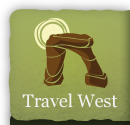Horseshoe Canyon
Distance:7.4 miles (round trip)
Walking time:4 1/4 hours
Elevations:540 ft. gain/loss Horseshoe Canyon Trailhead: 5,340 ft. Great Gallery pictograph panel: 4,800 ft.
Trail: The descent into the canyon is made on a slickrock trail with rock cairns. Inside the canyon a vague trail winds along the bottom of the sandy wash. There is intermittent water in the canyon, but it is usually stagnant.
Season:Spring, summer, fall, winter. The canyon is quite hot in midsummer, so carry plenty of water. For more information call the Hans Flat Ranger Station, Canyonlands National Park, at (801) 259-2652.
Vicinity:Horseshoe Canyon Detached Unit of Canyonlands National Park, near Hanksville
Horseshoe Canyon contains what is probably the finest display of prehistoric Indian rock art in the United States. The famous Great Gallery, largest of several Horseshoe Canyon sites, is 200 feet long, 15 feet high, and contains dozens of intriguing red, brown, and white pictographs. The paintings are at least 2,000 years old, and possibly as old as 8,000 years. Rock art is notoriously difficult to date accurately, but from the style we can be reasonably certain that the work was done by the so called Archaic People who lived in the area before the arrival of the Anasazi and Fremont Indian cultures. Archaic clay figurines that closely mimic the pictographs have been found about nine miles away in Spur Fork, a tributary of Horseshoe Canyon, and the figurines have been dated to about 4700 B.C.
For years archaeologists have struggled to interpret the strange anthromorphs that are depicted on the Great Gallery. In addition to many smaller figures, the huge panel contains about twenty life size human shapes, all of which have a strange mummy-like appearance. They lack arms or legs, and often have huge insect-like eyes and bucket-shaped heads. Most intriguing of all is the figure known as the “Holy Ghost”. This seven-foot-high painting stands out among the others because of its size and its ethereal appearance. Perhaps it was intended to portray a revered ancestor, or a mythical deity.
From the car parking area, the trail proceeds into the canyon along an old jeep road originally built by an oil exploration company. A barrier has been erected across the trail about 0.2 mile from the car park to keep recreational vehicles out, and another barrier has been placed 0.5 mile farther down to keep cattle out of the canyon. The trail finally reaches the canyon bottom 1.3 miles from the trailhead, then turns south along Barrier Creek. There is seldom running water in Barrier Creek, but the canyon is rarely completely dry either.
As you drop into the canyon you can see another jeep road descending from the opposite rim. This primitive road meets the trail at the canyon bottom, and for a while you will be walking on it. The road ends 0.6 mile upstream, just beyond the intersection of Water Canyon, where the Park Service has erected another barrier to keep vehicles out of upper Horseshoe Canyon.
As you approach Water Canyon be sure to watch for the first two pictograph sites, one on each side of the canyon. The trail passes right by them. These sites, like the other two that you will see later, were painted by the Archaic People between 2,000 and 8,000 years ago. The third site is situated in a huge alcove on the west side of the stream, about 0.6 mile up-canyon from the first two. Unfortunately the alcove site has sustained substantial damage, both natural and man-caused, and it is not as impressive as the others.
Finally, 1.3 miles from the alcove site, or 3.7 miles from the beginning of the trail, you will come to the Great Gallery. This display of rock art has been called the Louvre of the Southwest, and, indeed, it is a phenomenal relic of the past. Dozens of intricate human and animal figures decorate the panel, mostly in red, with some brown and white. The pigments were made from finely ground minerals, and then mixed with a liquid base, perhaps animal tallow or vegetable juices, to form a crude paint. After thousands of years all traces of the base have disappeared, but the mineral coloring still adheres to the rock and the paintings remain preserved in astonishing detail.
If you have sharp eyes, and if you are willing to walk just a little further, this hike will reward you with another unexpected bonus. About 0.2 mile upstream from the Great Gallery, Barrier Creek flows over a small slab of flat sandstone that appears harder and darker than the surrounding stone. Look carefully at the dark, flat surface near the west side of the creek, and you will see the tracks of a three-toed dinosaur that passed this way between 50 and 100 million years ago. The imprints are about ten inches in diameter, and there are at least three of them, spaced about four feet apart.
Did you like this page? Did you find it helpful? Please consider sharing.
